
The Democratic Republic of Georgia was the first modern establishment of a republic of Georgia, which existed from May 1918 to February 1921. Recognized by all major European powers of the time, DRG was created in the wake of the Russian Revolution of 1917, which led to the collapse of the Russian Empire and allowed territories formerly under Russia's rule to assert independence. In contrast to Bolshevik Russia, DRG was governed by a moderate, multi-party political system led by the Georgian Social Democratic Party (Mensheviks).

The Turkish War of Independence was a series of military campaigns and a revolution waged by the Turkish National Movement, after parts of the Ottoman Empire were occupied and partitioned following its defeat in World War I. The conflict was between the Turkish Nationalists against Allied and separatist forces over the application of Wilsonian principles, especially national self-determination, in post-World War I Anatolia and eastern Thrace. The revolution concluded the collapse of the Ottoman Empire; the end of the Ottoman sultanate and the Ottoman caliphate, and the Republic of Turkey was declared in Anatolia and eastern Thrace. This resulted in a transfer of vested sovereignty from the sultan-caliph to the nation, setting the stage for Republican Turkey's period of nationalist revolutionary reform.
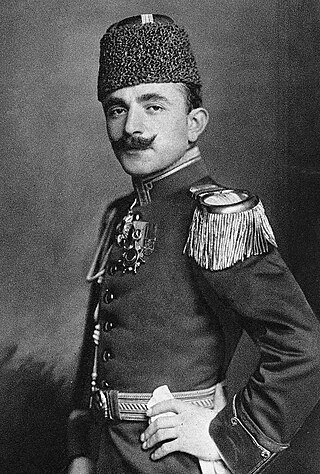
İsmail Enver, better known as Enver Pasha, was an Ottoman military officer, revolutionary, and convicted war criminal who was a part of the dictatorial triumvirate known as the "Three Pashas" in the Ottoman Empire.
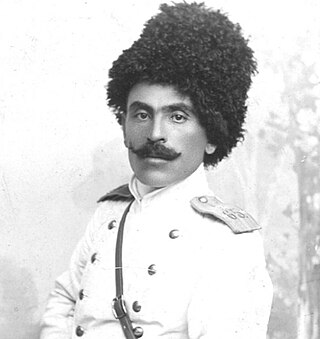
Giorgi Mazniashvili was a Georgian general and one of the most prominent military figures in the Democratic Republic of Georgia.

The history of Adjara, a region in the South Caucasus, stretches from its initial Stone Age settlement through to its present day status as Georgia's Autonomous Republic of Adjara.
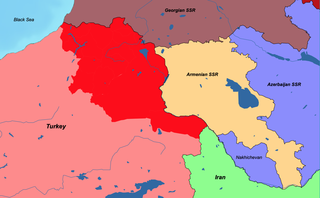
The Treaty of Kars was a treaty that established the borders between Turkey and the three Transcaucasian Soviet republics, which are now the independent republics of Armenia, Georgia and Azerbaijan. The treaty was signed in the city of Kars on 13 October 1921.

Musa Kâzım Karabekir was a Turkish general and politician. He was the commander of the Eastern Army of the Ottoman Empire during the Turkish War of Independence, and fought a successful military campaign against the Armenian Democratic Republic. He was the a founder and leader of the Progressive Republican Party, the Turkish Republic's first opposition party to Atatürk, though he and his party would be purged following the Sheikh Said revolt. He was rehabilitated with İsmet İnönü's ascension to the presidency in 1938 and served as Speaker of the Grand National Assembly of Turkey before his death.

Ali Fuat Cebesoy was a Turkish military officer who served in the Ottoman Army and then in the Turkish army and politician.

The Turkish–Armenian War, known in Turkey as the Eastern Front of the Turkish War of Independence, was a conflict between the First Republic of Armenia and the Turkish National Movement following the collapse of the Treaty of Sèvres in 1920. After the provisional government of Ahmet Tevfik Pasha failed to win support for ratification of the treaty, remnants of the Ottoman Army's XV Corps under the command of Kâzım Karabekir attacked Armenian forces controlling the area surrounding Kars, eventually recapturing most of the territory in the South Caucasus that had been part of the Ottoman Empire prior to the Russo-Turkish War (1877–1878) and was subsequently ceded by Soviet Russia as part of the Treaty of Brest-Litovsk.
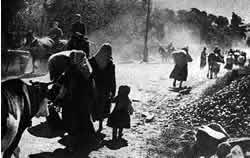
The Battle of Kars was the largest battle of the Turkish–Armenian War, which took place on October 30, 1920. It was fought between forces loyal to the Grand National Assembly under the command of Kâzım Karabekir and the army of the First Republic of Armenia. Karabekir's army captured the fortified city of Kars after launching a massive assault, taking minor casualties and capturing around 3,000 Armenian soldiers, as well as several high-ranking Armenian military officers and civilian officials. The swift capture of Kars opened the path for Turkish forces to advance towards Armenia's largest city at the time, Alexandropol, and effectively decided the outcome of the Turkish–Armenian War in the Kemalists' favor.

The Provisional National Government of the Southwestern Caucasus, Provisional National Government of South West Caucasia or Kars Republic was a short-lived nominally-independent provisional government based in Kars, northeastern Turkey. Born in the wake of the Armistice of Mudros that ended World War I in the Middle East, it existed from December 1, 1918 until April 19, 1919, when it was abolished by British High Commissioner Admiral Somerset Arthur Gough-Calthorpe. Some historians consider it to have been a puppet state of the Ottoman Empire.

The Partition of the Ottoman Empire was a geopolitical event that occurred after World War I and the occupation of Constantinople by British, French, and Italian troops in November 1918. The partitioning was planned in several agreements made by the Allied Powers early in the course of World War I, notably the Sykes–Picot Agreement, after the Ottoman Empire had joined Germany to form the Ottoman–German alliance. The huge conglomeration of territories and peoples that formerly comprised the Ottoman Empire was divided into several new states. The Ottoman Empire had been the leading Islamic state in geopolitical, cultural, and ideological terms. The partitioning of the Ottoman Empire after the war led to the domination of the Middle East by Western powers such as Britain and France, and saw the creation of the modern Arab world and the Republic of Turkey. Resistance to the influence of these powers came from the Turkish National Movement but did not become widespread in the other post-Ottoman states until the period of rapid decolonization after World War II.

The Red Army invasion of Georgia, also known as the Georgian–Soviet War or the Soviet invasion of Georgia, was a military campaign by the Russian Soviet Red Army aimed at overthrowing the Social Democratic (Menshevik) government of the Democratic Republic of Georgia (DRG) and installing a Bolshevik regime in the country. The conflict was a result of expansionist policy by the Russians, who aimed to control as much as possible of the lands which had been part of the former Russian Empire until the turbulent events of the First World War, as well as the revolutionary efforts of mostly Russian-based Georgian Bolsheviks, who did not have sufficient support in their native country to seize power without external intervention.
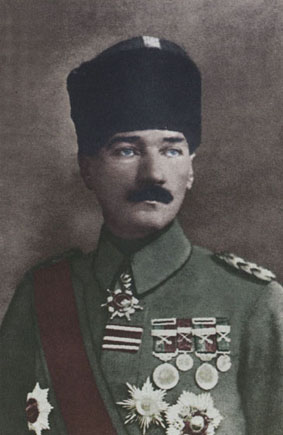
Mustafa Kemal Atatürk was a field marshal, revolutionary statesman, and founder of the Republic of Turkey as well as its first president. Mustafa Kemal Atatürk's military career explains his life between graduation from Ottoman War College in Istanbul as a lieutenant in 1905 to his resignation from the Ottoman Army on 8 July 1919, as well as his military leadership throughout the subsequent Turkish War of Independence.

Makhluto, born Smbat Boroyan, also known as General Smbat, was an Armenian fedayee commander during the Armenian national movement. He was known for his battles alongside General Andranik Ozanian.
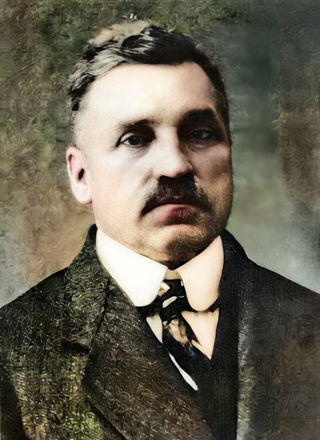
Selanikli Mehmed Nâzım Bey also known as Doktor Nazım was a Turkish physician, politician, and revolutionary. Nazım Bey was a founding member of the Committee of Union and Progress, and served on its central committee for over ten years. He played a significant role in the Armenian genocide and the expulsion of Greeks in Western Anatolia. He was convicted for allegedly conspiring to assassinate Mustafa Kemal Atatürk in İzmir and was hanged in Ankara on 26 August 1926. He also served as the chairman of the Turkish sports club Fenerbahçe S.K. between 1916 and 1918.

Soviet Union–Turkey relations were the diplomatic relations between the Soviet Union and the Republic of Turkey.

The Battle of Batumi was a military battle between Democratic Republic of Georgia and Turkey. The Georgian aim of this battle was to remove the Turkish army from Batumi.
The Battle of Artvin was a military confrontation between the Democratic Republic of Georgia and the Ottoman Empire in Artvin, present-day Turkey, on 20 April 1919, during the Turkish War of Independence. The battle resulted in a Georgian victory and the transfer of Artvin and Ardahan to Georgia.

During the Turkish War of Independence the United Kingdom sought to undermine and contain the Turkish National Movement. London hoped the defeated Ottoman Empire would play a subservient role in its new Middle Eastern order drawn up over several diplomatic agreements during World War I, culminating with the Treaty of Sèvres. Another goal of the British was to prosecute Ottoman war criminals, which they thought Constantinople/Istanbul was not taking seriously.



















